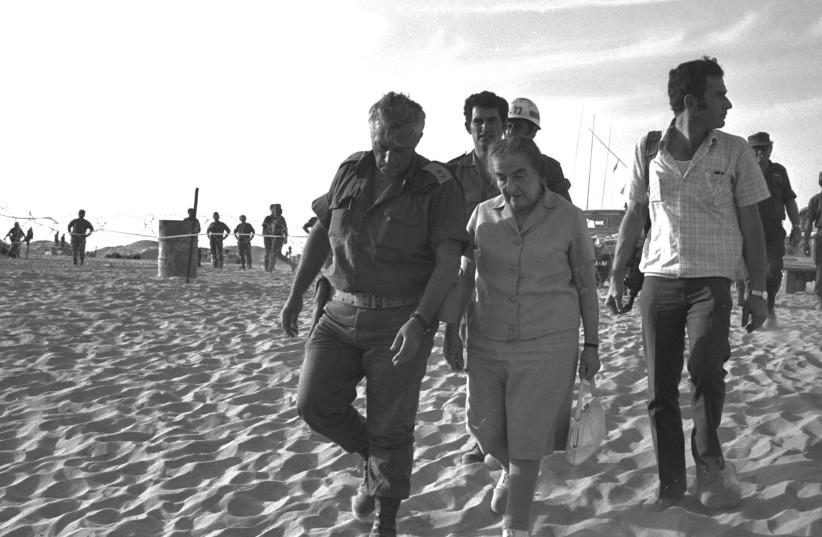Before 1973, the Hebrew word mechdal meant “a major blunder.” In the last 50 years, according to Uri Kaufman, author of Eighteen Days in October: The Yom Kippur War and How It Created the Modern Middle East, the term has taken on a new meaning: “a fiasco as monumental as the IDF’s failures in the opening days of the Yom Kippur War.”
In Eighteen Days in October, Kaufman draws on the memoirs of, and interviews with, participants in that war and recently declassified documents, in his detailed analysis of how Israel narrowly avoided a defeat that may well have ended the Jewish state.
In less than three weeks, he emphasizes, Israel repulsed a surprise attack by Egypt and Syria, surrounded the Egyptian Third Army in the Sinai, closed in on Damascus, and ended the conflict on favorable terms before it settled into a grinding war of attrition that 3.3 million people could not win against a combined population of 80 million.
An analysis of battles and diplomacy
Eighteen Days in October features a blow-by-blow analysis of dozens and dozens of battles. Informed, although at times at odds with the controversial conclusions of the Agranat Commission, the book also provides a balanced and blunt assessment of Israel’s military leaders, including then-defense minister Moshe Dayan; chief of staff David “Dado” Elazar; director of Military Intelligence Eli Zeira; commander of the Air Force Benny Peled; and generals Shmuel “Gorodish” Gonen and Ariel Sharon.
Kaufman tells the stories of soldiers like Asa Kadmoni, the war’s “greatest hero,” who despite a wound to his right hand, killed 30 Egyptians with a shoulder-fired missile, and scrambled onto a roof with a rifle and hand grenades, shooting anyone he could see before finally being rescued when he was down to only seven bullets.

Kaufman writes that, convinced that Arab leaders and military personnel had been traumatized by their defeat in 1967, Israeli Intelligence officials did not believe the movement of Egyptian and Syrian troops and weapons was a prelude to the surprise attack that was to commence on October 6, 1973.
In one of the best and “gutsiest decisions” of the war, however, Elazar, whom the Agranat Commission made the “sacrificial victim of Israelis’ frustrations,” relied on AMAN analysis and left the border with Jordan undefended, to be able to concentrate his forces in Sinai.
By contrast, Peled’s decision to destroy SAM missiles in the Golan Heights and call off Operation Tagar in Egypt was “Israel’s biggest tactical blunder, worse even than the decision not to mobilize the reservists.”
Gonen’s order to attack along the banks of the Suez Canal, which necessitated destroying Egypt’s Second Army across a 56-km. front instead of moving a short distance to the east, “was a brazen act of foolishness.”
Although Sharon routinely defied orders from superior officers and then lied about it, he also inspired “mystical confidence” among his troops and may have been the best divisional commander in the IDF. And Kaufman endorses prime minister Golda Meir’s “Forget about it” dismissal, delivered in English, of Dayan’s proposal to “begin preparations for a display of nuclear power.”
Although he had access to relatively few Egyptian and Syrian sources, Kaufman identifies blunders by Israel’s adversaries that played a pivotal role in the outcome of the Yom Kippur War. On October 13, Egyptian president Anwar Sadat refused to agree to a ceasefire unless Israel withdrew “behind the pre-June 5, 1967 lines” and Gazan Palestinians were granted their own state, Kaufman speculates, because Sadat was giddy at the prospect of a victory, which by that time had all but disappeared.
Rejection of the ceasefire, it turned out, gave US secretary of state Henry Kissinger the green light to airlift massive supplies of weapons to Israel. On October 14, moreover, Egypt launched an ill-advised offensive, and three days later withdrew troops from a strategic outpost, opening a backdoor that allowed Israel to lay bridges over the canal.
Primarily a history of military tactics and strategy, Eighteen Days in October also addresses diplomacy, albeit briefly. Kaufman reminds us that this war was fought in a Cold War context, with Egypt and Syria relying on weapons supplied by the Soviet Union, and Israel on those supplied by the United States.
Kissinger, he asserts, not all that convincingly, missed an opportunity to demand an end to OPEC’s oil embargo and cutbacks in production in exchange for a ceasefire that would prevent the destruction of Egypt’s Third Army.
When Kissinger demanded that Meir pull back to the October 22 ceasefire line, she maintained that doing so would allow the Third Army to resupply and resume fighting. Americans would be furious that they would have to endure oil shortages “over the issue of your right to hold territory you took after the ceasefire,” Kissinger replied – and claimed there was “next to no chance” Egypt would accept her proposal. He was wrong: The Egyptians gave in.
Israelis, Kaufman notes, “invariably” place Meir (who suffered from shingles, a recurrence of cancer, exhaustion, and perhaps depression, resigned in 1974 and died four years later) at the bottom of the nation’s prime ministers.
However, he ends his book with a revisionist argument: Anyone who connects the dots between the victory through strength she achieved and the Camp David Accords and the peace treaty with Egypt signed by Menachem Begin should rank her among Israel’s great wartime leaders.
A “lioness in orthopedic shoes,” Golda “defied the United Nations, stared down the Soviets, steamrolled the Egyptians, and outlasted the Americans” by exhibiting the same determination that “dictated the outcome on all the smoking battlefields of the Yom Kippur War. She “held out one minute longer.”
Glenn C. Altschuler is the Thomas and Dorothy Litwin Professor of American Studies at Cornell University.
- EIGHTEEN DAYS IN OCTOBER: The Yom Kippur War and How It Created the Modern Middle East
- By Uri Kaufman
- St. Martin’s Press
- 386 pages; $32
